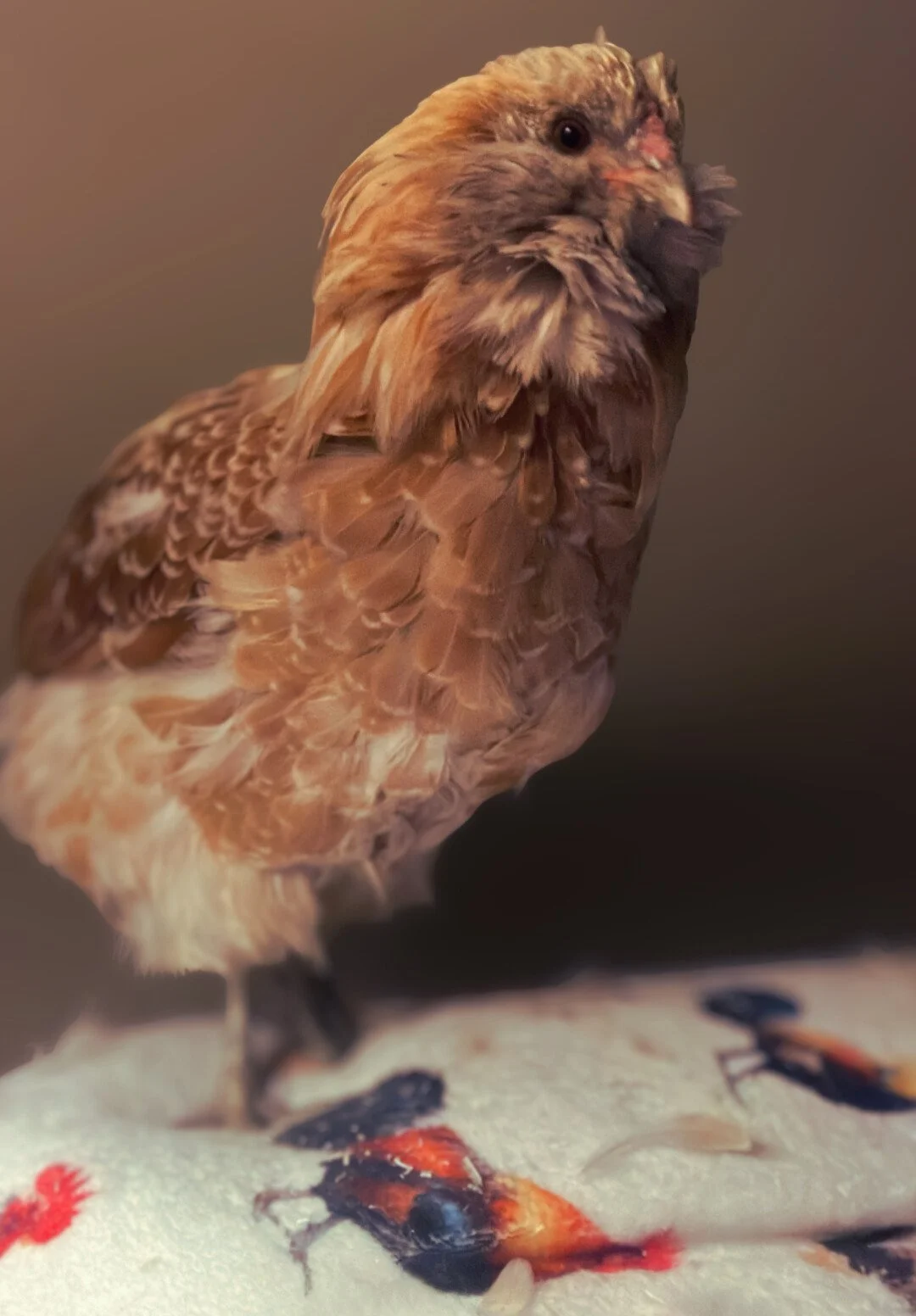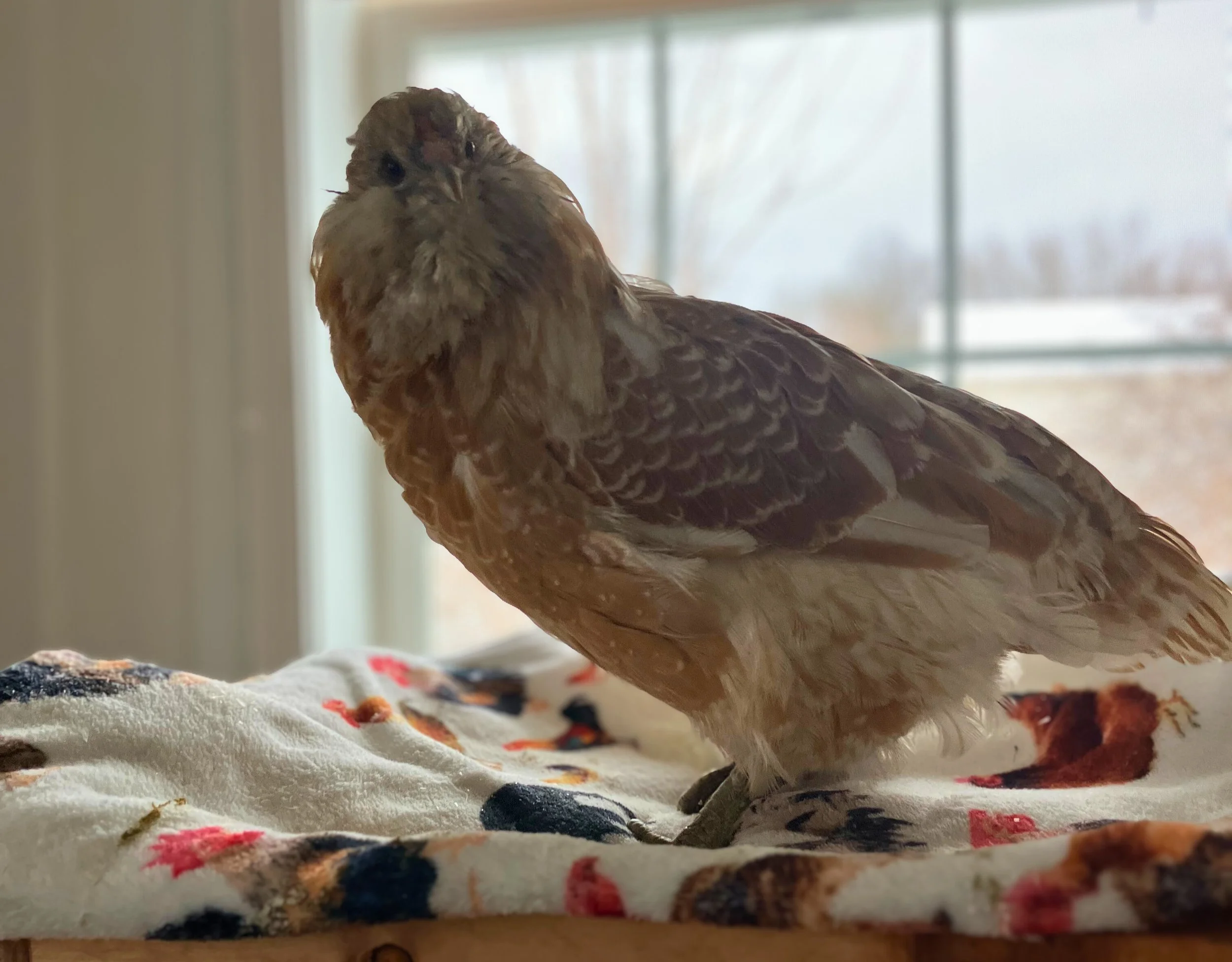Parry Hope: The Rule-Breaking House Chicken
Chris has been naming friends Parry H. since 1983. The first was pigeon Parry, who followed her home from work. Then came pug Parry Howard, and more dogs Parry Helen and Parry Harry. So when Chris responded to an internet post about a disabled chicken in the fall of 2022, tradition dictated she call her new avian companion Parry Hope.
Now almost three years old, Parry the hen is an established member of Chris’s family. Parry hatched with a leg deformity, but even with a leg eternally pointing backwards, she gets around! She spends the day dust bathing, napping, and snacking on kale and bread. Chris’s young granddaughters are Parry’s best friends, and carry her around on their adventures. When the day is done, Parry settles onto the couch with her own blanket (and newspapers on the floor–chicken diapers are not Parry’s style) for bedtime. In the morning, she waits to be carried to the kitchen for family breakfast, before commencing with her day.
Chris’s youngest son went vegan about 15 years ago, and recommended the book Mercy For Animals to her. After learning about the horrors of factory farming, Chris made changes to her life, diet, and the teaching plans she had for her middle school students. She incorporated lessons on plant-based food and animal farming, and explained how unique and special chickens are. To really drive the point home, she brought her chickens to class—much to the principal’s displeasure.
Chris, who began caring for a flock of chickens in 2018, knows that having a disabled house chicken is not a common thing. So when the family was set to move halfway across the country, Chris researched the laws in her new town to make sure Parry would be welcome, and determined there would be no zoning violation. As it was, Parry’s hometown had no issue with a chicken residing in the family home for ten months.
Therefore, it was a surprise when Chris opened official correspondence from the town after settling in. The town had declared Parry Hope to be an unacceptable household pet, and explained she was in violation of local ordinance. According to the town, Parry was a farm animal. In addition to paying a fine, Parry Hope would have to leave.
Unfortunately, the area had been recently re-zoned, or the town had a town change of heart regarding hens—the exact reasoning, and how the town even learned of Parry, was not explained. Had a neighbor filed a complaint with the town? To rule that out, Chris’s neighbors signed a petition stating the neighborhood took no issue with Parry. Chris had Parry designated as an emotional support animal hoping to resolve the issue, but the town contested.
Chris says she had “spent the previous 10 months falling in love with her. The thought of losing her was unbearable.” Humans routinely have to surrender their loved ones due to matters out of their control—governmental borders and directives, denied insurance claims, leases that prohibit nonhuman occupants. But when there’s a chance to fight back, humans fight for their family—so that’s what Chris did.
Devastated at the thought of rehoming Parry, Chris and her husband hired an animal rights lawyer. The legal fees were expensive, but necessary to keep Parry home. They needed to prove that this chicken was a member of the family, a distinguished individual who had every right to sleep on the couch every night. Parry may not be besties with the two dogs, but she was part of the pack (or flock, if you will).
—
Bylaws, ordinances, and permits regarding animal ownership vary by state, county, town, zoning, HOAs, and landlords. The rules are even more specific according to species and breed designation. Pets are different from livestock, a pug is different from a Rottweiler, and a rat in a cage is different from a rat in a barn.
For example, municipalities can designate that certain animal species, animal industries and businesses, or the rearing of animals, are limited to agricultural zones. The laws change in residential districts, often limiting the number of animals by species and “purpose” (a pet dog and a dog being used for breeding might be considered differently). Some towns require a permit and for the animals to be housed in a specific way. As far as Chris could tell from all public documents, Parry was not violating the stated regulations—but rarely does town hall imagine a chicken being invited into the living room to stay.
One could argue that, while intended for clarification, designations are not always helpful. The more categories and boxes that are made, the more exceptions there can be. The more exceptions there are, the more detailed the rules become. Is species really an important distinction when it comes to who deserves to be a “house pet”? What makes a parrot a pet and a chicken livestock? What makes a dog a house pet and a goat a farm animal? Perhaps the definitions of companion, family, and pet, need to be blurred.
Many regulations are in place to prevent cruelty, overcrowding, and unhygienic conditions. Raising chickens is allowed, but only in agricultural zones with enough land. But what about a single chicken who sleeps in the house and spends the day in a residential yard? At what point do laws stop being proactive and start preventing authenticity? What does it mean to live in community with other species? To have an inter-species family?
At the surface, it means fighting to keep your loved ones safe, perhaps unbeknownst to them, from the danger of separation. Yet, what can be expected when the government creates this exact situation for our own human species? Boundaries of belonging are intersectional, and reach to all of those we hold dear. Questioning the place of a chicken in a house as a loved one, and not in the kitchen as food—what will be pushed against next?! If society allows animals to have rights and comfort, then there is no explaining away the cruelty allowed against neighbors and each other.
—
Now, months after the initial correspondence and legal back-and-forth, the case is closed, according to Chris’s lawyer. There has been no formal resolution, but they are leaning into the adage “no news is good news.” It is a somewhat anticlimactic end to a frustrating ordeal that seemed to be predicated on red tape rather than a lived life. Did the town expect a dutiful resident who would simply get rid of a chicken? How many people think pushing back would be fruitless and therefore do not try? Did the town anticipate capitulation without questioning authority? Who fights for a chicken, an animal so few people consider to be a friend as opposed to food?
The moral of Parry Hope’s story is two-fold. The first is that chickens’ lives, as individuals, disabled or abled, are worth fighting for. Their lives contain multitudes of relationships, nuances of personality, and love across species.
The second moral is somewhat cliche, but cliches work for a reason. This one is “just because it’s always been this way, doesn’t mean it must always be this way.” Challenging authority is difficult, involves time, red tape, paper work, and legal fees. Not everyone who wants to make changes has the capacity to push back on the status quo, but for the people who can, pushing back is what saves lives. Today it might mean one house hen in one small town continues to go on adventures with the grandchildren. In the future, it might mean those grandchildren grow up to see animals as community, not commodities.
What has Parry taught Chris during their time together? It is an intentionally vague question that Chris responded to with obvious love and admiration:
“Everyday, I look at Parry as a member of the family. I am awestruck by her intelligence and the level of closeness we have. She tolerates my two- and five-year-old granddaughters when they pick her up. She is gentle with students when I bring her to school. I look in her eyes and see a creature (chickens) deserving of so much more.”
~
Thank you for reading a post on the LIC Blog! Views expressed in these blog posts are those of their authors and do not necessarily reflect the view of Legal Impact for Chickens.


